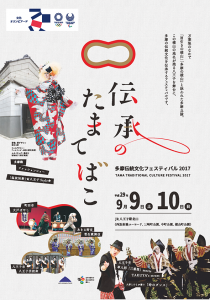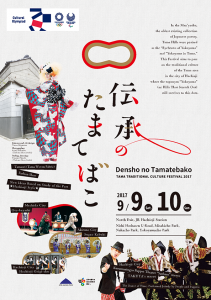In the ancient poetry collection The Manyoshu, the Tama Hills were called the “eyebrow ridge” or the Tama Yokoyama (ridgeway). Taking place in Hachioji city, which still has an area called Yokoyama, this festival carries on the traditional culture of the Tama region.
You’re sure to enjoy this impressive outdoor theatrical experience, which features a performance of “yorokobi sambaso”, an auspicious dance to pray for peace in the world, a bountiful grain harvest and the prosperity of the theater, as well as a children’s kabuki performance of Inasegawa Seizoroi no Ba (Act IV: Inase River Monologues) from “Shiranami Gonin Otoko” (“Five Men of the White Waves”).
Date: Saturday, September 9
Venue: Yokoyamacho Park stage
Performed by: Sugao Kabuki Sugao-ichiza
Fee: Free of charge, no reservation necessary
Tsugaru shamisen music evolved in Aomori Prefecture, and has been called “music for living”, representing and expressing the land, the wind and the ocean. Feel the pulse of life in the lovely timbre of a new-style of shamisen, brought to Hachioji by GAKU-FU.
Date: Saturday, September 9
Venue: Misakicho Park stage
Performed by: Tsugaru Shamisen GAKU FU (Kunigaku Sawada, Kunikaze Sawada)
Fee: Free of charge, no reservation necessary
When the techniques and wisdom developed by traditional tamaori weaving craftsman Shin Sawai meets the creative sensibility of artist Tamao Shigemune, the result is the kimono as wearable “real fashion”, a far cry from the traditional Japanese garment. You’re sure to enjoy this new style of kimono, which is both fashionable and carries a strong message.
Date: Saturday, September 9
Venue: Nishi Hoshasen U-Road (in front of the Ajiroen storehouse)
Performed by: Undecided (to include models chosen from members of the public)
Fee: Free of charge, no reservation necessary
A matsuri bayashi (traditional festival ensemble) normally consists of a small hand gong, a bamboo flute, and small and large taiko drums. During Shinto festivals, these ensembles sometimes play on top of decorated “dashi” festival floats, and may be accompanied by dancing and movement. Enjoy this revered form of traditional music, which has developed and been passed down in accordance with the traditions of Japanese life.
Date: Sunday, September 10
Venue: Misakicho Park stage
Performed by: Hachioji Matsuribayashi Rengokai
Fee: Free of charge, no reservation necessary
Hachioji is the only place in the Tama region with a geisha quarter. A friendly and familiar place to the townspeople, last year the geisha quarter saw the first “hangyoku” apprentice geisha debut to be made there in fifty years. Hachioji’s geisha have been keen to expand their activities beyond ozashiki formal geisha parties, performing geisha roles in a production of the opera “Madame Butterfly” (sponsored by Hachioji College Community & Culture Fureai Foundation), making appearances in NHK television dramas, and more. This performance of traditional Japanese dance by the Hachioji geisha who guard and cherish Japan’s traditional performing arts is the very essence of refinement, and a must-see.
Date: Saturday September 9 and Sunday, September 10
Venue: Nakamachi Park stage
Performed by: Hachioji geisha group
Fee: Free of charge, no reservation necessary
Traditional “kotobuki sambaso” ceremonial dancing prays for the safety of the theater at the opening of Ningyo joruri (Japanese puppet theater) and kabuki performances, as well as celebrating peace in the world, tranquility throughout the land and a bountiful grain harvest. In the first half of this event, kotobuki sambaso is overlaid with contemporary beats and rhythm. Kuruma ningyo (puppets operated by someone sitting on a small wheeled seat) will perform this ancient dance, with young and spirited street dancers borrowing and adapting the skillful gestures and the soul of the puppet expressed in the turn of its eyes. See how these collaborative performances of puppets and people bring together the old and the new at the sound of a bell.
For the second half, the troupe will perform a typical program of Hachioji Kuruma Ningyo style puppetry. A highlight is the tragic climax to Kiyohime’s jealous rage, in the puppet version of the Dojoji story set along the Hidaka river. Look out for the “gabu” vengeful spirit puppet head and it’s wide-open mouth.
Date: Sunday, September 10
Venue: Yokoyamacho Park stage
Performed by: Hachioji Kuruma Ningyo, Sekkyo-bushi no kai, TAKUYA
Fee: Free of charge, no reservation necessary
In the Edo Tenpo era, in what is now the Akuwa area of Seya-ku in modern-day Yokohama, Kunio Aizawa and fourteen others asked Manzo Goten, a teacher of Edo Kanda shitamachi bayashi festival music from the Shitamachi area of Tokyo, to instruct them in the traditions. Kunio Aizawa was subsequently adopted by the house of Yoshikawa in the Oto area of Aiharamachi in Machida. Local young men who idolized Kunio Yoshikawa’s style of matsuri bayashi received instruction from him: this was the foundation of the Oto bayashi style. Don’t miss this Oto bayashi ensemble, who have taken part in a slew of competitions like the All Kanto Matsuri Bayashi and Tokyo Metropolitan Matsuri Bayashi contests, winning championships and other prizes more than thirty times.
Date: Sunday, September 10
Venue: Nakamachi Park stage
Performed by: Oto Bayashi Preservation Society
Fee: Free of charge, no reservation necessary
This year’s Legendary Tamatebako will feature another lively parade following the tremendous response to the one last year. The Hachioji geisha group will parade on both days, Sugao Kabuki Sugao-ichiza will be out on the 9th, and the 10th will see the Nishikawa Koryu Troupe of the Hachioji Kuruma Ningyo puppet theater and Sekkyo-bushi no kai members parade through the streets in rickshaws. Onlookers will also enjoy the polished introductory address.
Date: Saturday September 9 and Sunday, September 10
Venue: Nishi Hoshasen U-Road
Performed by: Sojiro Okazakiya, Sakafuku Rickshaws, the Hachioji geisha group, Sugao Kabuki Sugao-ichiza, Nishikawa Koryu Troupe of the Hachioji Kuruma Ningyo puppet theater, Sekkyo-bushi no kai
Fee: Free of charge, no reservation necessary
Rickshaws appeared in Hachioji in around 1870 at the start of the Meiji era. At first they were almost exclusively for personal use, but from around 1875 commercial rickshaw businesses began operating. The rickshaws that used to zip around the streets in the Meiji, Taisho and Showa periods have vanished with the years, and plenty of people miss them.
Date: Saturday September 9 and Sunday, September 10
Venue: Nishi Hoshasen U-Road, Kurobei street, others
Fee: 1,000 yen per rickshaw / two person capacity / advance booking required for the five rickshaws on each tour.
Participation possible on the day if places available.
*Advance bookings taken until August 25. Details to be made available when decided.
Comprising the six tea schools of Urasenke, Edosenke, Omotesenke, Omotesenke Fuhaku-ryu, Sado Sohenryu and Dainippon Chado Gakkai, the Hachioji Tea Ceremony Federation invites you to enjoy some traditional hospitality at its Ryurei-style seated open-air tea ceremony, where you will be served green tea and sweets.
Date: Saturday September 9 and Sunday, September 10
Venue: Nishi Hoshasen U-Road (Misakicho Park to Nakamachi Park)
Fee: 500 yen per person / advance booking required.
Participation possible on the day if places available.
*Advance bookings taken until August 25. Details to be made available when decided.
Why not have a go at weaving using a hand loom that has been in use in Hajioji since the Taisho era? Traditional weaver Shin Sawai gives a gentle introduction to the craft. This is your chance to experience the crossing of warp and weft (vertical and horizontal threads) in hand weaving, so please feel free to come along.
Date: Saturday September 9 and Sunday, September 10
Venue: Nishi Hoshasen U-Road (Yokoyamacho Park to Nakamachi Park)
Fee: Free (experience only), 500 yen (coaster-making)/ advance booking required.
Participation possible on the day if places available.
*Advance bookings taken until August 25. Details to be made available when decided.
Legendary Tamatebako Office (in Hachioji College Community & Culture Fureai Foundation)
TEL: 042-621-3005

